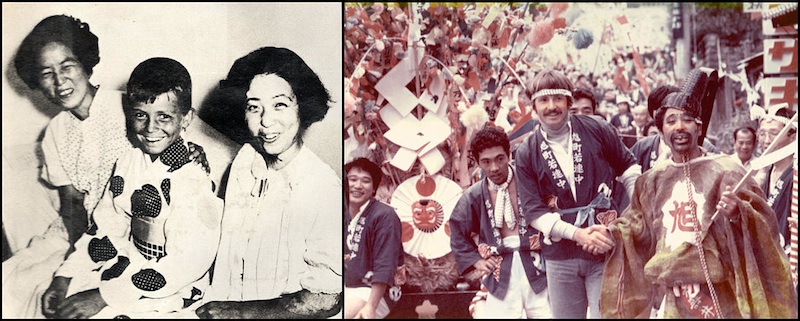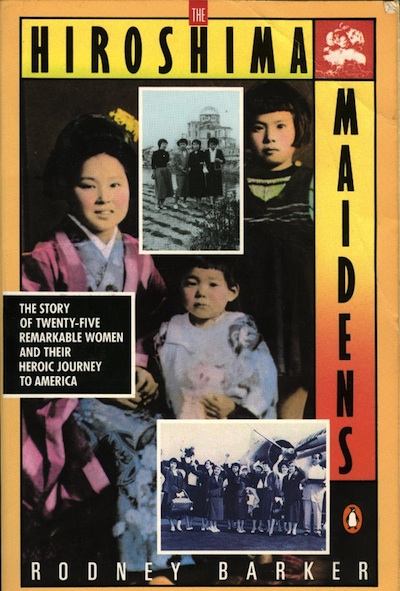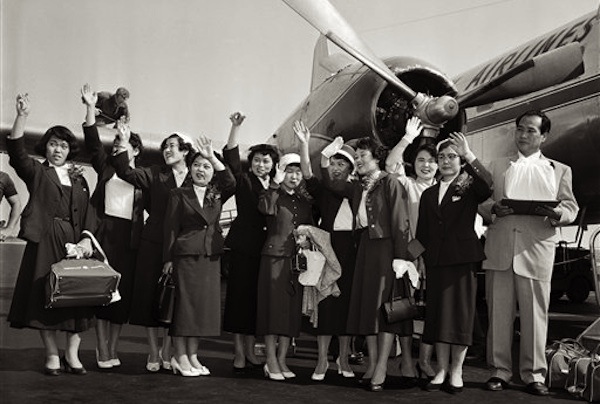August 6, 2015 marks the 70th anniversary of the dropping of the first atomic bomb on a human population, specifically the people of Hiroshima, Japan. As a commemorative series, Women Of Green is taking a look back at the impact of nuclear war on the live of women. This is the third post in the series.
Author Rodney Barker’s ‘Hiroshima Maidens’ details remarkable, little-known Hiroshima Survivor Stories
Barker’s new ebook gives us a penetrating and very personal look at some miraculous Hiroshima survivor stories. It is a humanitarian epic that reveals a side of the Hiroshima story very few Americans have heard.
Most Americans know that seventy years ago, the detonation of the first atomic bomb on the Japanese city of Hiroshima ushered in the Nuclear Age. It was a moment full of horror, in which the eyes of the whole world were opened to the unimaginable possibility of nuclear holocaust. What very few American know is that it was also a moment that gave birth to a remarkable collective act of courage, compassion, and redemptive hope, symbolized by the young women who made it happen: the “Hiroshima Maidens”.
Here is a little-known piece of history about Hiroshima: the story of how twenty-five young Japanese women, crippled and disfigured by the effects of the atomic blast, banded together to fight against their despair. They were brought to the United States in 1955 for plastic surgery – lodged in American homes and operated on at New York’s Mount Sinai Hospital – in a remarkable humanitarian effort that is itself an epic. There are elements here, too of the comedy of manners, in the story of these twenty-five girls acclimatizing themselves to new places and new ways; and in the chronicle of how they did so a portrait of a now-vanished America – the America of the mid-1950s – emerges.

Left, a young Rodney Barker (in kimono) with two Hiroshima Maidens, 1955. Right, Barker as Festival Honoree in Japan, 1983.
But the heart of this remarkable book, republished now in ebook format in recognition of the 70th anniversary, is the story of how these twenty-five young women, schoolgirls when the bomb destroyed their lives and their futures, remade those lives and re-created themselves. Rodney Barker was in a unique position to observe how they did so.
 The son of one of the host families, he was nine years old when two Maidens came to live in his house; he was like a little brother to them, and when, nearly thirty years later, he resolved to make their story better known to the world, he was able to inspire the kind of trust and candor in his sources that could only come from a sense of shared experience and intimacy.
The son of one of the host families, he was nine years old when two Maidens came to live in his house; he was like a little brother to them, and when, nearly thirty years later, he resolved to make their story better known to the world, he was able to inspire the kind of trust and candor in his sources that could only come from a sense of shared experience and intimacy.
Focusing on three of the Maidens, but drawing on and relating the experiences of all of them, he follows them from the terrifying moments of the bomb blast, through their years of pain and shame in their own country, to their not always idyllic stay in America; and he traces their lives since – some marked by tragedy, some by heroism, some by an affecting and hard-won ordinariness.
“The story was widely covered in the media,” Barker stated, “with reporting that ranged from the political – many people saw the Maidens as dramatic symbols of the horrors of atomic warfare and incorporated their suffering into an argument for the abolition of nuclear weapons – to the humanitarian – others focused on the project as an example of American benevolence and a dramatic display of traditional American compassion for disaster victims. But the story rapidly faded from public view when the women returned to Japan and all but disappeared.”
“Until the early 1980’s, that is, when I received a research grant that allowed me to travel to Hiroshima to track down the surviving Maidens, and tell their story. ‘The Hiroshima Maidens’ was published by Viking-Penguin in 1985, on the 40th anniversary of the bombing, the 30th anniversary of the Maidens project.”
As I began to research a foreword to the book, the natural questions occurred to me. How many of the Maidens were still alive? What did the rest of their lives look like? How did their unique experiences – they were struck by lightning twice: once when the bomb exploded in a clear morning sky, and again when they were brought to the enemy country for help and healing – fit into the larger historic narrative of the city of Hiroshima itself.”
The original book received rave reviews from critics. The Cleveland Plain Dealer called the book, “A testament to the perseverance of a group of Americans and Japanese determined to salvage some human value from the wreckage of Hiroshima.” The Los Angeles Times stated the book is ” . . .controlled, fearsome, wonderful, appalling.” The New York Times said it “evokes a range of human emotions that has been lost in the dead vocabulary of annihilation and deterrence.” The new ebook includes a new afterword in honor of the 70th anniversary of the Hiroshima bombing. In the Afterword Barker discusses the impact the book has had on the way people think about nuclear weapons, and the contemporary relevance of this story – a story that must be preserved as part of our national memory.
About Rodney Barker:
Rodney Barkers family were Quakers, and regularly opened their home to others less fortunate: Fresh Air Fund kids from the inner cities; a foreign exchange student from Brazil; two of the Hiroshima Maidens and two of the Ravensbruck Lapins: Polish women subjected to senseless medical experiments by Nazi doctors. Sitting in on all those interviews by reporters who came to the house, and listening to the dramatic, human stories that were told, inspired him and set his course as a writer. The new ebook is available at Amazon. More information is available at Barker’s website.
Watch an interview with Rodney Barker on The Authors Show.
Source: HeavenOnEarth.com
Women Of Green needs YOUR voice to be part of the conversation. We encourage your comments and questions below, on facebook/womenofgreen, and on twitter/womenofgreen. Say It and Share It! We’re here to Turn Up The Volume!
